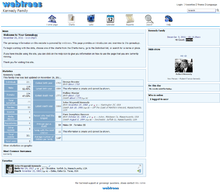 webtrees 1.2.4 | |
| Original author(s) | Greg Roach and John Finlay (PhpGedView) |
|---|---|
| Developer(s) | Greg Roach The webtrees team[1] |
| Initial release | August 26, 2010[2] |
| Stable release | 2.1.18[3] |
| Repository | |
| Written in | PHP, JavaScript |
| Available in | 36 languages[4] |
List of languages Arabic, Bosnian, Bulgarian, Catalan, Chinese, Croatian, Czech, Danish, Dutch, English (GB, US), Estonian, Finnish, French, German, Greek, Hebrew, Hungarian, Icelandic, Italian, Lithuanian, Korean, Norwegian (Bokmål and Nynorsk), Persian, Polish, Portuguese (BR, PT), Russian, Slovak, Slovene, Spanish, Swedish, Tatar, Turkish, Ukrainian and Vietnamese. Partial translations for Yiddish, Galician, Indonesian, Romanian, Serbian and Japanese. | |
| Type | Genealogy software |
| License | GPL-3.0-or-later |
| Website | webtrees |
webtrees is a free open source web-based genealogy application intended for collaborative use.
It requires a web server that has PHP and MySQL installed.
It is compatible with standard 5.5.1-GEDCOM files.
YouTube Encyclopedic
-
1/2Views:1 302714 249
-
The webtrees Genealogist: Adding a Census Record
-
It's raining spiders! Spider rain phenomenon explained
Transcription
History
webtrees is a fork of PhpGedView, it was created in early 2010, when a majority of active PhpGedView developers stopped using SourceForge[5][6] due to issues with exporting encrypted software.[7][8] webtrees is the second fork of PhpGedView. In late 2005 the first one, called Genmod,[9] was created.
On 26 July 2010, a month before version 1.0.0 of webtrees was released, Dick Eastman, who publishes Eastman's Online Genealogy Newsletter, introduced webtrees as "the wave of the future."[10]
The day version 1.0.0 of webtrees was released, Tamura Jones reviewed and compared Webtrees with PhpGedView.[11]
References
- ^ The webtrees team
- ^ webtrees Wiki:History
- ^ "Release 2.1.18". 18 October 2023. Retrieved 20 October 2023.
- ^ "Translation status". lanchpad.net. Retrieved 2013-06-23.
- ^ "PhpGedView forum thread 2010-02-10: PGV blocked in Cuba, Syria, etc". Retrieved 2010-11-11.
- ^ "PhpGedView forum thread 2010-02-18: Future of PGV". Retrieved 2010-11-11.
- ^ "SourceForge blog 2010-01-25: Clarifying SourceForge.net's denial of site access for certain persons in accordance with US law". Retrieved 2010-11-11.
- ^ "SourceForge blog 2010-02-07: Some good news: SourceForge removes blanket blocking". Retrieved 2010-11-11.
- ^ "SourceForge blog 2005-10-24: A new start..." Retrieved 2010-11-11.
- ^ "Eastman's Online Genealogy Newsletter 2010-07-26: WebTrees - a New Web-based Genealogy Program". Retrieved 2010-11-11.
- ^ "Modern Software Experience 2010-08-26: Webtrees - web genealogy". Retrieved 2010-11-11.
